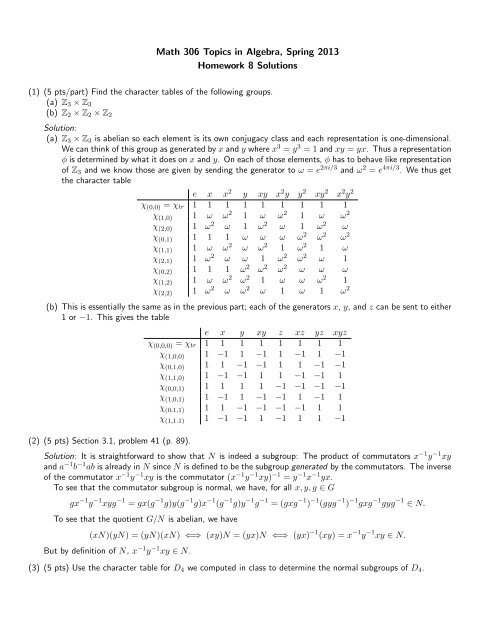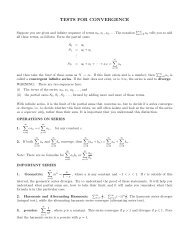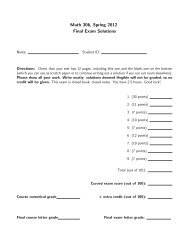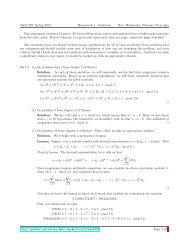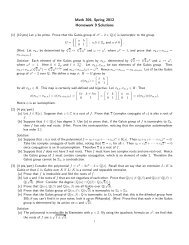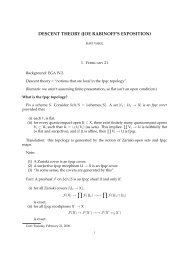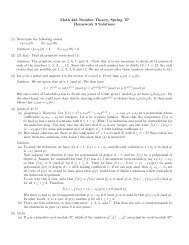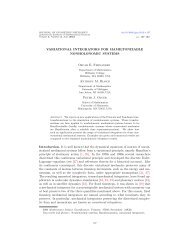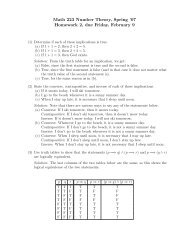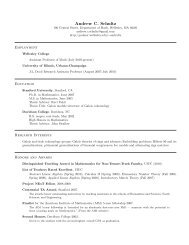Math 306 Topics in Algebra, Spring 2013 Homework 8 Solutions
Math 306 Topics in Algebra, Spring 2013 Homework 8 Solutions
Math 306 Topics in Algebra, Spring 2013 Homework 8 Solutions
You also want an ePaper? Increase the reach of your titles
YUMPU automatically turns print PDFs into web optimized ePapers that Google loves.
<strong>Math</strong> <strong>306</strong> <strong>Topics</strong> <strong>in</strong> <strong>Algebra</strong>, Spr<strong>in</strong>g <strong>2013</strong><strong>Homework</strong> 8 <strong>Solutions</strong>(1) (5 pts/part) F<strong>in</strong>d the character tables of the follow<strong>in</strong>g groups.(a) Z 3 × Z 3(b) Z 2 × Z 2 × Z 2Solution:(a) Z 3 × Z 3 is abelian so each element is its own conjugacy class and each representation is one-dimensional.We can th<strong>in</strong>k of this group as generated by x and y where x 3 = y 3 = 1 and xy = yx. Thus a representationφ is determ<strong>in</strong>ed by what it does on x and y. On each of those elements, φ has to behave like representationof Z 3 and we know those are given by send<strong>in</strong>g the generator to ω = e 2πi/3 and ω 2 = e 4πi/3 . We thus getthe character tablee x x 2 y xy x 2 y y 2 xy 2 x 2 y 2χ (0,0) = χ tr 1 1 1 1 1 1 1 1 1χ (1,0) 1 ω ω 2 1 ω ω 2 1 ω ω 2χ (2,0) 1 ω 2 ω 1 ω 2 ω 1 ω 2 ωχ (0,1) 1 1 1 ω ω ω ω 2 ω 2 ω 2χ (1,1) 1 ω ω 2 ω ω 2 1 ω 2 1 ωχ (2,1) 1 ω 2 ω ω 1 ω 2 ω 2 ω 1χ (0,2) 1 1 1 ω 2 ω 2 ω 2 ω ω ωχ (1,2) 1 ω ω 2 ω 2 1 ω ω ω 2 1χ (2,2) 1 ω 2 ω ω 2 ω 1 ω 1 ω 2(b) This is essentially the same as <strong>in</strong> the previous part; each of the generators x, y, and z can be sent to either1 or −1. This gives the table(2) (5 pts) Section 3.1, problem 41 (p. 89).e x y xy z xz yz xyzχ (0,0,0) = χ tr 1 1 1 1 1 1 1 1χ (1,0,0) 1 −1 1 −1 1 −1 1 −1χ (0,1,0) 1 1 −1 −1 1 1 −1 −1χ (1,1,0) 1 −1 −1 1 1 −1 −1 1χ (0,0,1) 1 1 1 1 −1 −1 −1 −1χ (1,0,1) 1 −1 1 −1 −1 1 −1 1χ (0,1,1) 1 1 −1 −1 −1 −1 1 1χ (1,1.1) 1 −1 −1 1 −1 1 1 −1Solution: It is straightforward to show that N is <strong>in</strong>deed a subgroup: The product of commutators x −1 y −1 xyand a −1 b −1 ab is already <strong>in</strong> N s<strong>in</strong>ce N is def<strong>in</strong>ed to be the subgroup generated by the commutators. The <strong>in</strong>verseof the commutator x −1 y −1 xy is the commutator (x −1 y −1 xy) −1 = y −1 x −1 yx.To see that the commutator subgroup is normal, we have, for all x, y, g ∈ Ggx −1 y −1 xyg −1 = gx(g −1 g)y(g −1 g)x −1 (g −1 g)y −1 g −1 = (gxg −1 ) −1 (gyg −1 ) −1 gxg −1 gyg −1 ∈ N.To see that the quotient G/N is abelian, we have(xN)(yN) = (yN)(xN) ⇐⇒ (xy)N = (yx)N ⇐⇒ (yx) −1 (xy) = x −1 y −1 xy ∈ N.But by def<strong>in</strong>ition of N, x −1 y −1 xy ∈ N.(3) (5 pts) Use the character table for D 4 we computed <strong>in</strong> class to determ<strong>in</strong>e the normal subgroups of D 4 .
Solution: Tak<strong>in</strong>g all possible <strong>in</strong>tersections of the kernels of the characters, we get that the normal subgroupsare {1}, {1, ρ 2 }, {1, ρ, ρ 2 , ρ 3 }, {1, ρ 2 , σ, σρ 2 }, {1, ρ 2 , σρ, σρ 3 }, D 4 .(4) (7 pts) F<strong>in</strong>d the character table for A 4 and use it to f<strong>in</strong>d the normal subgroups of A 4 .Solution: Recall thatA 4 = {1, (12)(34), (13)(24), (14)(23), (123), (132), (124), (142), (134), (143), (234), (243)}.This group has four conjugacy classes with representatives 1, (12)(34), (123), and (132). There are thus fourirreducible representations.To f<strong>in</strong>d the 1-dimensional representations, it is not hard to see that the commutator subgroup is[A 4 , A 4 ] = {1, (12)(34), (13)(24), (14)(23)},and soA 4 /[A 4 , A 4 ] ∼ = Z/3Z.(S<strong>in</strong>ce the commutator has order 4, the quotient must have order 3.)So the three 1-dimensional representations of Z/3Z, given by 1 ↦→ ω where ω 3 = 1, lift to A 4 .We then have12 = |A 4 | = 1 2 + 1 2 + 1 2 + d 2 ,from which it follows that the last representation has dimension 3. Denote its character by χ 4 and letχ 4 ((12)(34)) = a, χ 4 ((123)) = b, and χ 4 ((132)) = c. We now use the orthogonality relations to obta<strong>in</strong> asystem1 · 3 · 1 + 3 · a · 1 + 4 · b · 1 + 4 · c · 1 = 01 · 3 · 1 + 3 · a · 1 + 4 · b · ω + 4 · c · ω 2 = 01 · 3 · 1 + 3 · a · 1 + 4 · b · ω 2 + 4 · c · ω = 0from which it follows that a = −1, b = c = 0. The character table is thus1 (12)(34) (123) (132)χ 1 = χ tr 1 1 1 1χ 2 1 1 ω ω 2χ 3 1 1 ω 2 ωχ 4 3 −1 0 0From the table we see that the only values of a character that equal the dimension of the correspond<strong>in</strong>grepresentation is χ 2 ((12)(34)) = χ 3 ((12)(34)) = 1. Thus the only proper normal subgroup of A 4 is{1, (12)(34), (13)(24), (14)(23)}.(5) (5 pts) Look up the def<strong>in</strong>ition of a (left) ideal of a r<strong>in</strong>g R. Show that any (left) ideal of R is a (left) moduleover R.Solution: If I is an ideal, the action R × I → I is just multiplication <strong>in</strong> R, namely (r, i) ↦→ ri. Module axiomsare satisfied because of the def<strong>in</strong>ition of an ideal (<strong>in</strong> particular, ri is always an element of I).(6) (5 pts) Section 10.1, problem 9 (p. 344).Solution: Let Ann(N) be the annihilator of N <strong>in</strong> R. Suppose r ∈ Ann(N), a ∈ R, and n ∈ N. We have toshow ar, ra ∈ Ann(N). We have(ar)(n) = a(rn) = 0s<strong>in</strong>ce rn = 0, and(ra)(n) = r(an) = rn ′ = 0for some n ′ ∈ N. Hence Ann(N) is a two-sided ideal of R.
(7) (5 pts) Section 10.1, problem 18 (p. 344).Solution: Recall that an F [x]-module is a vector space V along with a l<strong>in</strong>ear transformation T : V → V . It isthen not hard to see that an F [x] submodule is precisely a subspace which is T -stable, i.e. a subspace W ⊂ Vsuch that T (W ) ⊂ W (see page 341 for more details). If T is the rotation of R 2 about the orig<strong>in</strong>, the onlysubspaces that T -stable are {0} and R 2 (all other subspaces are l<strong>in</strong>es through the orig<strong>in</strong>, and these are rotated),so these are the only two possible submodules.(8) (4 pts) Show that any r<strong>in</strong>g with identity is a Z-algebra.Solution: By def<strong>in</strong>ition, a r<strong>in</strong>g A with identity is a Z-algebra if there is a r<strong>in</strong>g homomorphism f : Z → A send<strong>in</strong>gunit to unit such that f(Z) ∈ Z(R). But send<strong>in</strong>g 1 ∈ Z to someth<strong>in</strong>g determ<strong>in</strong>es the homomorphism. In otherwords, we can def<strong>in</strong>e f by n ↦→ nf(1) = 1 R + 1 R + · + 1 R (added n times; if n < 0, then we add −1 R to itselfn times). It is easy to check that this is <strong>in</strong>deed a homomorphism.Further,m(nf(1)) = m(1 R + · + 1 R ) = m + m + · · · + m = (1 R + · · · + 1 R )m = (nf(1))m,so f(Z) is <strong>in</strong> the center of A.


